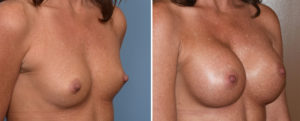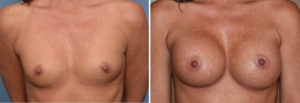Background: Cleavage is defined as the area between the breasts. It usually confers that the inner or medial part of the breast mound encroaches upon the flat sternum which lies between the breasts. While the term defines a certain breast appearance it usually refers to a look that is seen in clothing such as a low cut shirt or blouse, lingerie or swimwear. For Western cultures cleavage is usually viewed as an important element of femininity and sexual attractiveness.
Patients have many expectations from breast augmentation surgery and having cleavage afterwards is often one of them. Having much fuller inner breast mounds that are more prominent and rounder with the breasts fully exposed is often their goal. This is somewhat ironic in that how cleavage is usually perceived is in clothes with a low neckline. Thus surgically enhancing a fully exposed breast that has a cleavage appearance is a bit unnatural and is asking the breast implant to do what clothing usually creates. This is particularly true in today’s modern positioning of the implant in the submuscular location.
But what defines whether cleavage is the result of placing breast implants or not is the patient’s chest anatomy and the size and positioning of the implant. Breast mound and nipple spacing between both sides is a major factor. Many women simply have very widely spaced breasts and no matter what size breast implant is placed, augmented inner breast fullness is not going to occur.
Case Study: This 42 year-old female presented for breast augmentation. She had small breast with good skin. Her nipples were located on the breast mound at the mid-clavicular level.

Whether cleavage will result from breast augmentation depends on the spacing of the breast mound and nipples, the location of implant placement (subfascial vs submuscular), the size and projection of the breast implant and the amount of tissue quality that makes up the breast mounds. For most women undergoing breast enhancement prominent cleavage will not be the result. But when several of the natural breast characteristics are just right, some women will indeed develop an inner breast appearance that can appear without clothes to what it may be in clothes.
Highlights:
1) Breast implants rarely create cleavage for most breast augmentation patients.
2) The spacing of the breasts and the width of the sternal gap are the main natural limitations to breast augmentation cleavage.
3) When the distance from the sternum to the nipples is 12 cms or less, and the breast implants are of adequate size, postoperative cleavage can occur.
Dr. Barry Eppley
Indianapolis, Indiana



